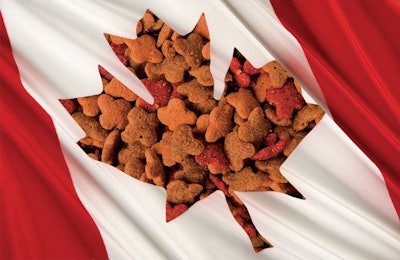
Increased humanization of pets in Canada and the growth of premium brands have fueled pet food sales in 2017, according to two Euromonitor International reports on cat food and dog food in Canada.
Large multinational brands, such as Nestlé Purina PetCare Co. and Mars Canada Inc., continue to dominate Canada’s pet food market. The two brands account for 60 percent of cat food value sales and 50 percent of dog food sales, according to the Euromonitor report. However, as pet owners seek more premium products, smaller domestic brands have an opportunity to increase their presence in the market with natural, organic and locally grown ingredients.
Overview: Canada’s pet food market
Canada’s economy is in recovery after a recent recession, similar to the US economy, but Canada’s pet food market has grown at a slow and steady pace since 2010, hovering at a 4 percent rate, according to a Canadian pet market outlook report from Packaged Facts. “Differentiation and premiumization are the factors leading pet food sales in Canada,” said Shirish Ghimire, market research associate at Dogsee Chew, an India-based premium dog treat company. “Even though the dog population is decreasing, the dog food market is increasing by value and quantity, with the dog treats section being the leader.”
Packaged Facts reports that the Canadian pet population is getting older, which may lead to a rise in health-focused pet food products, such as Greenies dental treats for dogs. Pharmaceutical health care companies, such as Bayer and Perrigo, have increased their production of pet health products for Canadian consumers. The continued humanization of pets fuels the premium pet food market in Canada, as health-conscious consumers want human-grade food for their pets.
“The rise in pet anthropomorphism has led to the natural and organic wave,” said Ghimire. “This trend will keep growing in the next few years as people become more health conscious for their pets. This trend will also challenge existing companies in the Canadian pet food industry who deal with regular pet foods.”
Foreign brands see opportunities in Canada’s pet food market
Meanwhile, foreign brands have noticed a potential for expansion into the growing Canadian pet food market. Dogsee Chew is one company looking to break into the Canada market and compete with other premium brands. “Since foreign brands are already leading the market, Dogsee can break into the Canadian market and compete,” said Ghimire. “If the available domestic brands are premium, consumers may prefer domestic brands … However, that doesn’t necessarily mean that consumers will go for domestic brands and boycott foreign premium products provided they are sold at reasonable prices,” said Ghimire.
Another attractive feature of the Canada market for Dogsee Chew is the rapid growth of dog treats sales. In a 2016–2020 forecast, dog treats have a higher CAGR (compound annual growth rate; 3.9 percent) than any dog food category, according to a pet food sales report from Agriculture and Agri-Food Canada (see Figure 1). Cat treats follow the same trend with a CAGR of 2.1 percent for 2016–2020, while dry and wet cat food fall below 2.1 percent.
Domestically, of course, there are some power players, too. Alberta, Canada-based Champion Petfoods is among the top 30 pet food companies in the world (with a revenue of US$!80 million in 2016, according to WATT Global Media's Top Pet Food Companies Database) and continues to expand its production capabilities while exporting to more than 70 countries worldwide. Ontario, Canada-based Elmira Pet Products leads the country's private-label industry for dry pet food manufacturing, according to the company, while serving the pet food markets of nearly every region of the world.
According to Ghimire, the leading sellers of dog treats in Canada are Whimzees, a Dutch brand, and Greenies, a US brand. Both brands favor the premiumization trend, marketing their treats as all-natural and healthy. Canadian premium dog treat brands such as Snack 21 and Orijen are also increasing their presence in the market.
The future of Canada’s pet food market
As in the US and other markets, e-commerce is a fast-growing pet food distribution channel in Canada. According to Ghimire, e-commerce has increased competition by bringing all the players (both big and small companies) on the same platform.
In the third quarter of 2017, Amazon’s sales in Canada’s pet product sector were smaller than in France, the UK and Germany at CAD5 million. However, Canada’s Amazon sales in pet products did see growth of 149 percent, led by health care items.
Overall, according to a Packaged Facts outlook report, the continued rise of premium and superpremium pet food products will drive sales in the Canadian pet market to US$9.2 billion by 2019.
Packaged Facts anticipates a 2 percent CAGR for cat food in value terms at constant 2017 prices over 2016–2022. Dog food sales are anticipated to see a 2 percent CAGR in volume terms and a 3 percent CAGR in value terms at constant 2017 prices over 2017–2022. Larger international brands will be forced to produce more premium products in order to remain competitive in the growing market.
More on Canada’s e-commerce pet food sales


















